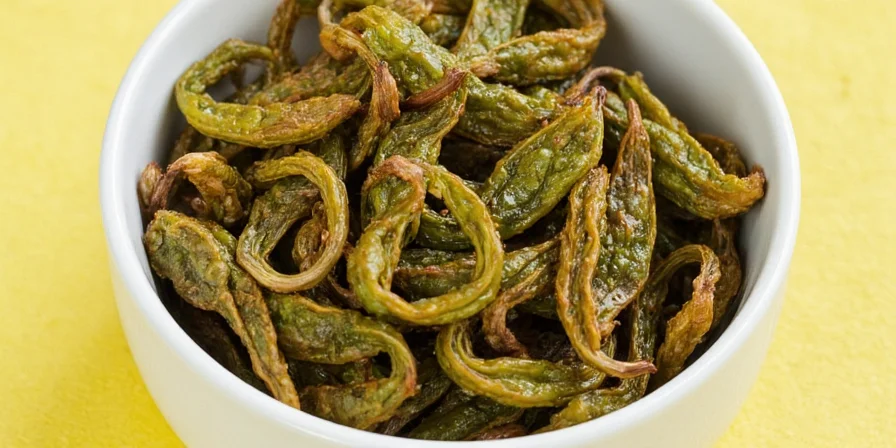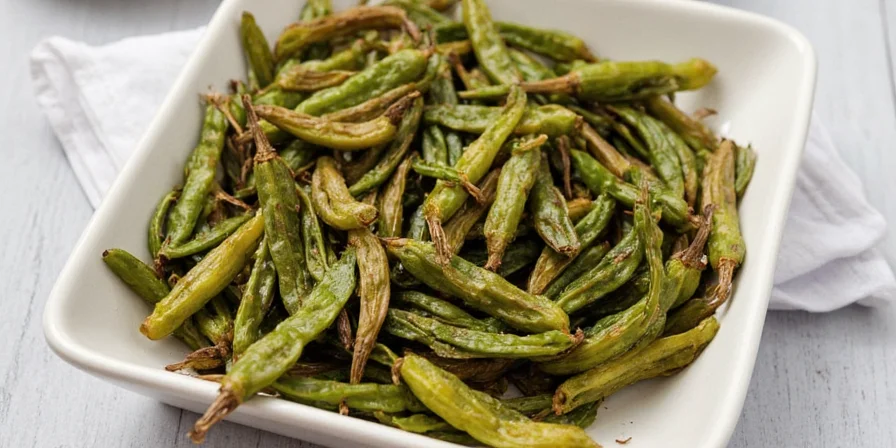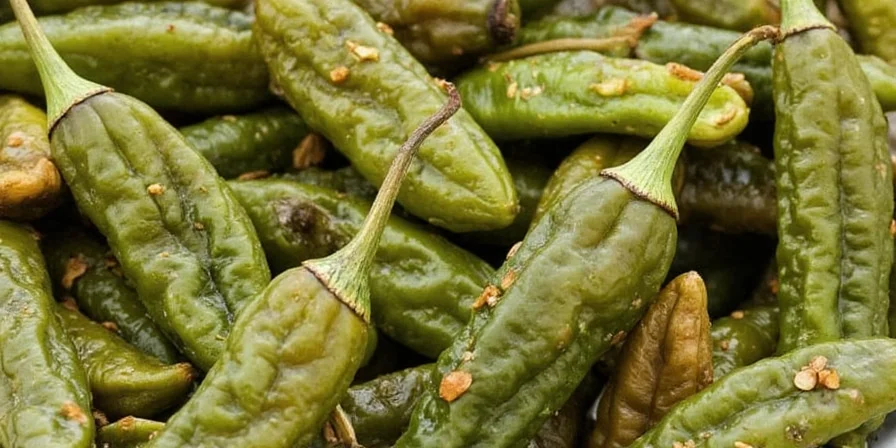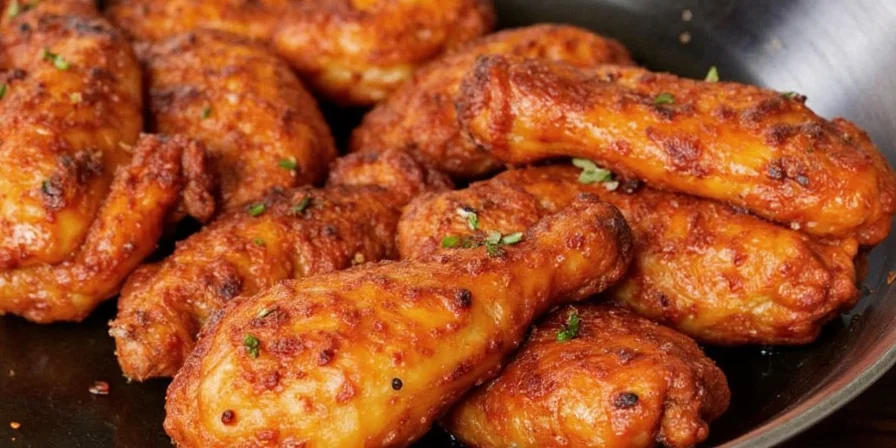Dried green peppers offer a unique grassy, vegetal flavor profile with milder heat compared to dried red peppers. Unlike their red counterparts which develop sweetness through ripening, green peppers are harvested early and dried, preserving their fresh, herbal notes while concentrating capsaicin. This comprehensive guide provides professional culinary techniques specifically for working with dried green pepper varieties including poblano, guajillo, and jalapeño.
Table of Contents
- Dried Green Peppers vs Red: Key Differences
- Tip #1: Proper Rehydration Technique for Maximum Flavor Extraction
- Tip #2: Optimal Toasting Temperatures for Green Varieties
- Tip #3: Precision Grinding for Consistent Texture
- Tip #4: Storage Methods That Preserve Green Pepper Characteristics
- Tip #5: Culinary Pairings That Highlight Green Pepper Nuances
- Tip #6: Understanding Specific Green Pepper Heat Profiles
- Tip #7: Creating Balanced Blends with Green Pepper Dominance
- The Science: Why Green Peppers Maintain Distinct Flavor Profiles When Dried
- Professional FAQs About Dried Green Peppers
- Conclusion: When to Choose Green Over Red
Dried Green Peppers vs Red: Key Differences
Dried green peppers are harvested before full ripening (typically at 60-70 days) while red peppers continue maturing on the plant. This fundamental difference creates distinct chemical compositions:
- Green dried peppers contain higher chlorophyll levels, yielding grassy, vegetal notes
- Lower sugar content prevents caramelization during drying, preserving sharper flavor profiles
- Average heat levels 20-30% milder than equivalent red varieties due to capsaicin concentration differences
- More pronounced fresh pepper aroma compounds remain after drying
These characteristics make dried green peppers ideal for dishes requiring subtle heat with fresh pepper essence, whereas red dried peppers deliver sweeter, smokier profiles better suited for rich stews and moles.
Tip #1: Proper Rehydration Technique for Maximum Flavor Extraction
Professional chefs use precise rehydration methods to optimize green pepper flavor compounds without compromising their delicate vegetal notes:
- Use 175°F (80°C) liquid for 18-22 minutes (exactly timed) - hotter water destroys volatile compounds
- Add 1 tablespoon rice vinegar per cup of liquid to preserve chlorophyll structure
- Never exceed 30 minutes soaking time to prevent bitterness in green varieties
For optimal results, use the reserved soaking liquid in sauces at a 1:3 ratio with stock. This technique specifically enhances the fresh pepper aroma compounds that distinguish green dried peppers from red varieties.
Tip #2: Optimal Toasting Temperatures for Green Varieties
Toasting dried green peppers requires lower temperatures than red varieties to prevent scorching their delicate compounds:
- Medium-low heat (275-300°F / 135-150°C) for 45-60 seconds per side
- Flip every 15 seconds for even exposure
- Remove immediately when edges darken slightly
This precise technique develops nutty undertones while preserving the distinctive chlorophyll-based grassy notes that red dried peppers lack. Exceeding 325°F (163°C) causes green pepper varieties to develop bitter compounds not present in red peppers.
Tip #3: Precision Grinding for Consistent Texture
Commercial chili powders often blend multiple pepper types, masking green pepper characteristics. For authentic green pepper flavor:
- Use cooled, toasted peppers (room temperature) for consistent grinding
- Process in small batches (¼ cup max) to prevent overheating
- Sift through 40-mesh strainer for uniform particle size

This method preserves volatile flavor compounds that evaporate at higher temperatures, maintaining the fresh pepper aroma profile unique to green dried varieties. Store immediately in airtight containers away from light.
Tip #4: Storage Methods That Preserve Green Pepper Characteristics
Green dried peppers degrade faster than red varieties due to lower carotenoid content. Professional preservation techniques include:
- Vacuum seal with oxygen absorber packets (250cc size per quart)
- Store at 60°F (15°C) or below - every 18°F (10°C) increase doubles degradation rate
- Include silica gel packs (10g per 100g peppers) to maintain 15% optimal moisture level

Properly stored, dried green peppers maintain optimal flavor for 8-10 months versus 12-14 months for red varieties. Check quarterly for aroma intensity - fading grassy notes indicate declining quality.
Tip #5: Culinary Pairings That Highlight Green Pepper Nuances
Green dried peppers complement ingredients that would overpower red pepper flavors. Professional pairings include:
- Lime zest + rehydrated jalapeño = bright, clean heat for fish dishes
- White miso + guajillo = umami-rich vegetarian broth base
- Green olive brine + poblano = complex brininess for braises

The chlorophyll-based flavor compounds in green dried peppers interact with acidic ingredients differently than red peppers, creating brighter, more complex heat profiles ideal for delicate proteins and vegetable-forward dishes.
Tip #6: Understanding Specific Green Pepper Heat Profiles
Green dried pepper varieties offer distinct heat progression and flavor notes. This reference chart helps select the right variety:
| Pepper Type | Harvest Stage | Heat Progression | Peak Flavor Notes | Best Culinary Applications |
|---|---|---|---|---|
| Poblano (Ancho) | 60-70 days | Gradual build, 15-20 sec duration | Grassy, earthy, bell pepper | Chiles Rellenos, sauces requiring mild heat |
| Guajillo | 70-80 days | Immediate, 10-15 sec duration | Tangy, berry-like, vegetal | Salsas, marinades, broths |
| Mirasol | 65-75 days | Quick peak, 8-12 sec duration | Nutty, floral, herbal | Dry rubs, grilling, roasted dishes |
| Jalapeño (Chipotle) | 55-65 days | Fast, intense, 25-30 sec duration | Sharp, vegetal, bright | Salsas, pickled items, ceviche |
Tip #7: Creating Balanced Blends with Green Pepper Dominance
Professional chefs create signature blends emphasizing green pepper characteristics:
- "Fresh Heat Blend": 3 parts Guajillo, 2 parts Mirasol, 1 tsp dried lemon verbena
- "Green Mole Base": 4 parts Ancho, 1 part Guajillo, ½ tsp Mexican oregano
- "Bright Rub": 2 parts Jalapeño, 1 part toasted cumin, ¼ tsp coriander
Process: Toast spices separately at specified temperatures (Guajillo 275°F, Ancho 290°F, Jalapeño 260°F), cool completely, then blend. Store in dark glass containers. These blends specifically leverage green peppers' grassy notes that would be overwhelmed in traditional red pepper blends.
The Science: Why Green Peppers Maintain Distinct Flavor Profiles When Dried
Chlorophyll degradation pathways differ significantly between green and red peppers during drying. While red peppers develop complex Maillard reaction compounds from higher sugar content, green peppers preserve fresh pepper volatile compounds:
- 2-methoxy-3-isobutylpyrazine (green bell pepper aroma) remains stable during drying
- Lower pH (4.8-5.2 vs 5.5-6.0 in red) preserves chlorophyll structure
- Capsaicinoid profile shows higher 6-vinyl capsaicin (grassy note contributor)

This chemical profile explains why green dried peppers deliver immediate fresh pepper aroma with gradual heat build, contrasting with red peppers' sweet-smoky profile and faster heat onset. For optimal flavor release, incorporate green dried peppers early in cooking to allow volatile compounds to infuse the dish.
Professional FAQs About Dried Green Peppers
Why do dried green peppers have a grassier flavor than red varieties?
Dried green peppers retain higher chlorophyll content and specific volatile compounds like 2-methoxy-3-isobutylpyrazine that create grassy notes. Red peppers undergo chemical changes during ripening that convert these compounds into sweeter, caramelized flavors through Maillard reactions.
What's the precise rehydration temperature for dried green peppers?
Professional chefs use 175°F (80°C) water for 18-22 minutes. Higher temperatures degrade chlorophyll structure while lower temperatures fail to fully rehydrate the peppers. Adding 1 tablespoon rice vinegar per cup of liquid preserves the pH balance critical for maintaining green pepper characteristics.
How long do dried green peppers maintain optimal flavor compared to red?
Dried green peppers maintain peak quality for 8-10 months when properly stored versus 12-14 months for red varieties. This shorter shelf life stems from lower carotenoid content which acts as a natural preservative in red peppers. Check quarterly for fading grassy aroma as the primary freshness indicator.
When should I choose dried green peppers over fresh in recipes?
Use dried green peppers when you need concentrated grassy flavor without excess moisture. They work best in dry rubs, spice blends, and dishes requiring longer cooking times where fresh peppers would break down. Substitute 1 teaspoon crushed dried green pepper for 1 fresh medium pepper, adjusting for heat level differences between varieties.
Conclusion: When to Choose Green Over Red
Dried green peppers provide a unique flavor dimension unavailable from red varieties. Their grassy, vegetal notes with gradual heat progression make them ideal for dishes where fresh pepper essence matters more than intense smokiness. Understanding the chemical differences between green and red dried peppers allows precise application in culinary creations.
For optimal results, prioritize freshly dried green peppers with vibrant color and strong aroma, use precise rehydration temperatures, and store properly to maintain their distinctive characteristics. This knowledge transforms dried green peppers from overlooked ingredients to essential components in a professional spice arsenal.










 浙公网安备
33010002000092号
浙公网安备
33010002000092号 浙B2-20120091-4
浙B2-20120091-4